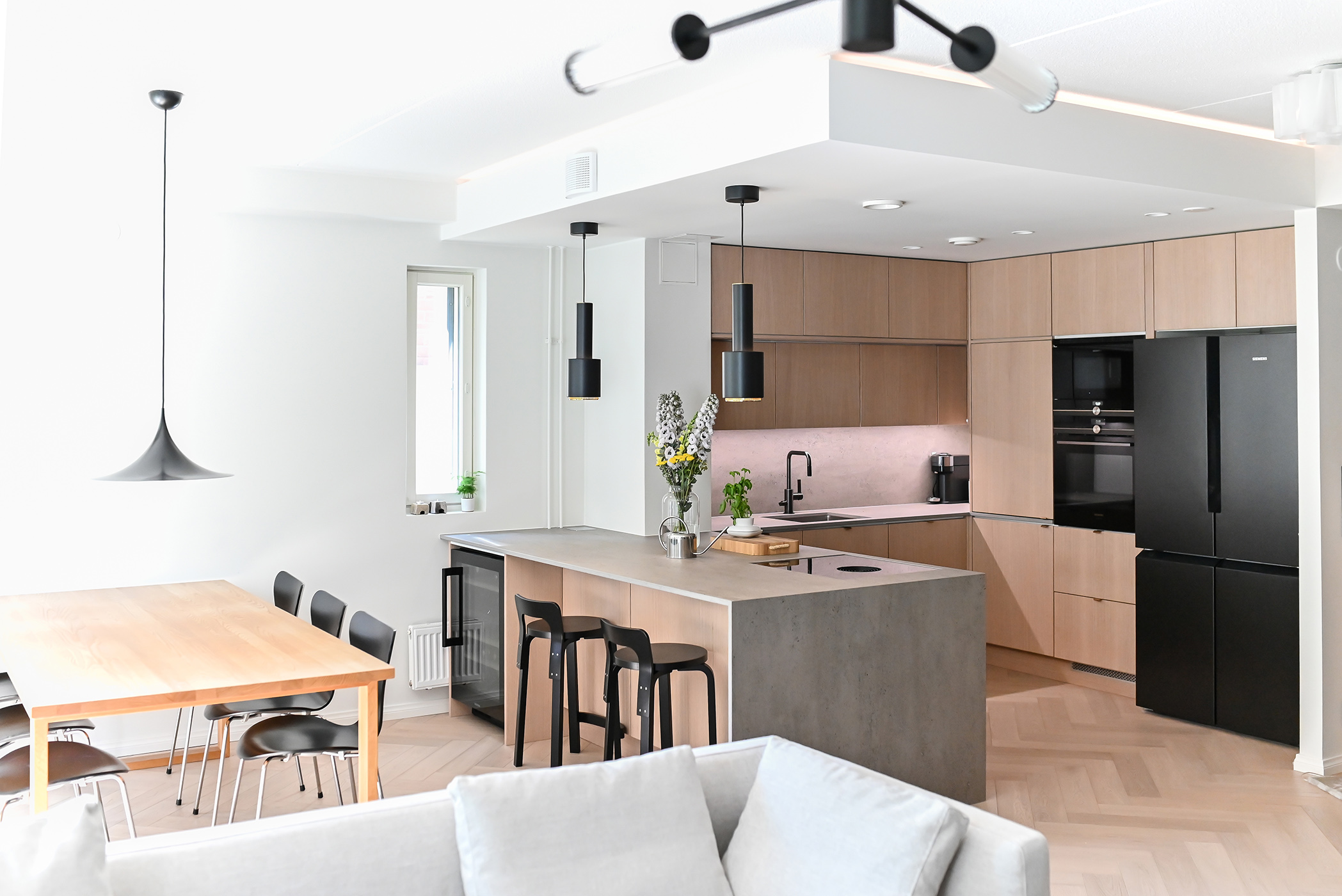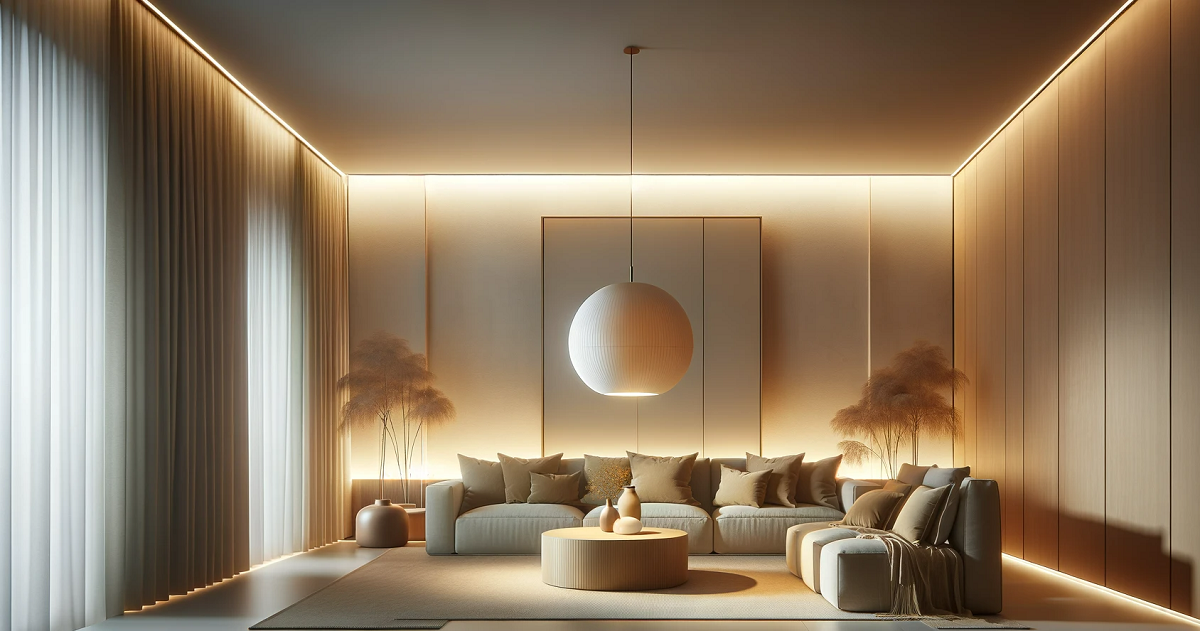As you navigate the sea of lighting options, you may feel confused when you’re on the verge of upgrading your home lighting. You need to weigh the brightness and colour temperature of the different lamps, reflected in the lumen and kelvin values. In this article we offer tips on what to consider when choosing lighting.
Key observations to start with
It’s important to choose a good colour rendering index that makes the colours in the room pop. For outdoor luminaires, a proper IP rating is vital. You also need to consider how you control the lights – do you use switches, dimmers or smart systems? Finally, don’t forget how the style of your lighting fixtures fits into your overall interior design. Keep these tips in mind, and illuminate your space with both function and style.
The main issues
- Consider the lumen value of the luminaires in relation to the desired brightness. Preferably too much.
- The colour rendering of lighting affects the mood and functionality of a space.
- Energy efficiency is important for cost savings and reducing environmental impacts.
- Choose a control system that suits your daily needs and improves the usability of your space.
Evaluation of light levels
Assessing the amount of light is the first step in upgrading your home lighting. Updating lighting requires careful planning, and the amount of light should not be left to guesswork. The higher the lumen value, the more light you get from the lamp. This is particularly important when you need bright light for working or reading.

If you’re wondering how much light, choose too much rather than too little, because you can always dim it. Also remember that your lighting designer will help you calculate the amount of light according to the space.
Choice of luminaires
The choice of luminaires has a big impact on how light is distributed in different spaces. In the kitchen and work areas, brighter lighting is usually recommended, while softer lighting is suitable for the living room and bedroom. The luminaire can be larger or, alternatively, several smaller light sources, as required. One large luminaire can easily simulate a skylight, such as a large 600×1200 light panel, but many small ones give a different feel to a space.
Be sure to pay attention to details such as the colour temperature and the colour rendering index of the luminaire. A good colour rendering index is above 90, preferably CRI95.
The colour rendering index tells you how well a luminaire reproduces colours – the higher the value, the more natural the impression. By thinking about these things, you can make sure that your lighting is just right for you and that the quality of light meets even the most demanding needs.
The importance of colour tones
Why is colour temperature important? When choosing your lighting fixtures, you should carefully consider their colour temperature, as this directly affects the mood and functionality of the room. Warm white light creates a warm and inviting atmosphere in the living areas of the home, while cooler white light is more suitable for spaces where people concentrate on things like working or reading.
When choosing luminaires, think about what kind of light is needed in the space. Special luminaires, such as CCTs, can adjust the colour temperature according to the situation, offering flexibility and adaptability.
It’s a good idea to include a variety of luminaires that provide both warm and cool light in your lighting design, so you can create a variety of lighting solutions.
The uniformity of the colour temperature of light is important to maintain a harmonious atmosphere in a space. Luminaires that offer the same colour temperature help to create a coherent look throughout the home. BUT, it is not wrong to use a mix of warm and neutral light in the same space. warm for pendant lights and more neutral for general lighting.
Remember that lighting should always match the purpose of the space and the desired mood. By choosing the right colour temperature, you can make lighting not only beautiful but also practical.
The importance of energy efficiency
When upgrading your lighting, consider energy efficiency, as it not only saves you money, but also reduces your environmental impact. Luminaires play an important role in the energy consumption of the home and energy efficiency is now a major concern. They are both an economic choice and a responsible act for the planet.

When choosing new luminaires, keep the following in mind:
- Lumen value (lm): choose a lamp with an adequate lumen value. Lighting does not have to be excessive, but just the right amount of light can make a difference to energy consumption. Better too much than too little.
- Kelvin value (K): the right Kelvin value ensures that you can choose just the right colour temperature to create the desired mood while being energy efficient.If in doubt, choose CCT adjustable.
- Colour rendering index (CRI/Ra): luminaires with a high CRI reproduce colours better, which can save energy because less lighting is needed and colours look cleaner.
- Protection against external factors: choose luminaires suitable for areas exposed to humidity or outdoor air, with appropriate IP ratings to ensure their longevity and safety. These luminaires are resistant to external factors, providing peace of mind and lasting performance.
Remember that all these factors can and should be considered together. A uniform colour temperature throughout the room is recommended, and the location of light switching is also important for energy efficiency.
Remember that lighting can always be made to match the old and that innovative lighting solutions are available, so you don’t have to sacrifice comfort for energy efficiency.
Choose a control system
When considering a lighting upgrade, it is important to choose a control system that meets your daily needs and facilitates the use of your space. The choice of control system is a key factor in how you interact with lighting. Smart lighting allows you to schedule and remotely control lights, matching the mood to different activities and times of day. This is offered by e.g. Zigbee, controlled by Azoula HUB.

With smart lighting, you can adjust the lighting with a few taps on your smartphone or tablet, which can make a big difference to the mood of your space. Dimmers allow you to adjust the brightness, creating the perfect mood for different situations. Wireless control options mean you can say goodbye to visible wires, while keeping your home looking tidy. You can also add control buttons where they didn’t exist before, without any electrical work.
Consider how the luminaires and their controls work together. In one room, you may want lighting that can change from vibrantly energising to soft and relaxing (colour temperature control, CCT). This is where the choice of control system comes into play. You can set situations and presets that are activated at the touch of a button, seamlessly integrating lighting into your everyday life.
In addition, integrating sensors can further enhance the experience by automatically adjusting luminaires and overall lighting based on the presence of people or the time of day. And, for example, connecting lighting to a home automation system can improve the control of different devices, making everyday life a little easier. Always ask for more information on this topic when planning your lighting!
Frequently asked questions
What is the height of the ceiling light?
When deciding how high to hang a ceiling light, take into account the purpose of the room and the material of the ceiling. You want to balance light intensity and energy efficiency. The design of the luminaire should complement your interior, and remember that maintenance is easier when it is accessible. The direction and colour tones of light affect the mood, so choose wisely. Proper installation techniques are important, and the right height will enhance the distribution of light, making your space both functional and inviting.
What is the right size for a lamp on a dining table?
When choosing a pendant light for your dining table, you want to consider the size of the light in relation to the table. Remember that the lamp should not be as long and wide as the table, so you don’t hit your head on it. Preferably 20cm smaller in each direction.
Make sure the design of the lamp matches your interior and choose the colour temperature to suit the mood you want to create. Choose adjustable light output for flexibility and prioritise energy efficiency to save on your electricity bills.
What size lamp would suit your living room?
When choosing a light for your living room, size matters. The size of the luminaire is affected by the height and width of the room. Too small a luminaire in a high space will look like a “toothpick”, while too large will eat up space. Also consider the room’s colour scheme and furniture arrangement to ensure harmony. Aim for a balance in choosing the intensity and shade of light that suits the purpose of the room. Smart investment strategy, energy efficiency and material compatibility are key. Your light should not only illuminate; it should create an atmosphere, making your living room a cosy oasis.
Conclusion
When it comes to lighting renovation, remember that you’re not just choosing light fixtures; you’re creating a symphony of light that breathes life into your home. The right luminosity will make your colours sing and your energy levels cry with joy. Choose a control system that feels like nature and a lighting type that reflects your soul.

